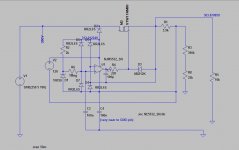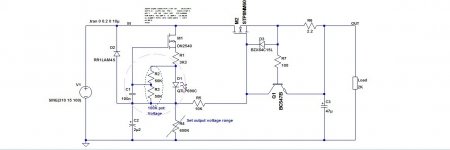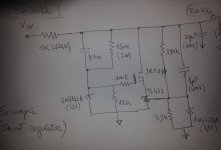A few days ago I came across a circuit on tubelab, interesting in my opinion, dating back to about twenty years ago. It relies on an opamp as a voltage reference using a certain feedback (error opamp). The resulting circuit is claimed to have low noise and output Z, and stability regarding output voltage drift.
The opamp in question then is fed directly from the AC voltage of the filaments as a voltage doubler (DC floating voltage). There's to say that, according to the author, it must have certain requirements: OP27 is mentioned (unity gain stable at operating conditions) but other cheaper ones I think can be used (NE5534?).
I tried a simulation and gave excellent results, but you know there is half a sea between saying and doing... so I was wondering if it could respond to real needs for powering a pre/phono.
The opamp in question then is fed directly from the AC voltage of the filaments as a voltage doubler (DC floating voltage). There's to say that, according to the author, it must have certain requirements: OP27 is mentioned (unity gain stable at operating conditions) but other cheaper ones I think can be used (NE5534?).
I tried a simulation and gave excellent results, but you know there is half a sea between saying and doing... so I was wondering if it could respond to real needs for powering a pre/phono.
Attachments
Ah interesting, well if this one can work I thought to try it (since I have a 6.3Vac output free). I prefer avoid a zener regulated psu
You can get auxiliary power with an LND150 and a pass transistor --
I've run Jan's T-Reg (cited above) through its paces, and it tests very well.
I've run Jan's T-Reg (cited above) through its paces, and it tests very well.
Floating regulators were an inconvenient constraint and necessity in the early days (the need for one or more floating, auxiliary supplies): look at the schematics of early HP supplies, or some Elektor projects.
Fortunately, we have progressed, and such cheap tricks are no more required: it is possible to build a very good non-floating regulator, and also a floating reg not requiring an auxiliary supply.
Jan's regulator is a good example, and I have also proposed a number of alternatives, some fully discrete others opamp-based.
It is always intellectually easier to build circuits like spice projects, where you can throw any arbitrary source anywhere into the game, but being able to do it physically too doesn't mean it's a good idea: it adds complexity and other problems, like the capacitance between the main and auxiliary supply. Truly floating supplies exist in sim, not in the real world.
Fortunately, we have progressed, and such cheap tricks are no more required: it is possible to build a very good non-floating regulator, and also a floating reg not requiring an auxiliary supply.
Jan's regulator is a good example, and I have also proposed a number of alternatives, some fully discrete others opamp-based.
It is always intellectually easier to build circuits like spice projects, where you can throw any arbitrary source anywhere into the game, but being able to do it physically too doesn't mean it's a good idea: it adds complexity and other problems, like the capacitance between the main and auxiliary supply. Truly floating supplies exist in sim, not in the real world.
Elvee, I actually tried to replicate one of your previous circuit working through CCS (DN2540) that feeds a mosfet but I ran into some stability issues. I noticed that one Supertex is not replicable to another and the Vout is not perfectly predictable based on the resistive network below.
The T-reg mentioned is an excellent kit it seems to me, although not very cheap but maybe it's worth it.
Jackinnj, can you please post the auxiliary circuit you told?
The T-reg mentioned is an excellent kit it seems to me, although not very cheap but maybe it's worth it.
Jackinnj, can you please post the auxiliary circuit you told?
Attachments
This floating technique was widely used in lab PSU’s and gives excellent results. If you reference the control amp to ground, you have to provide some sort of level shifting to control the series pass element and that often entails the introduction of an additional pole in the loop gain which can be problematic. The old LM723 (RIP) showed a nice example using this approach.
LND150 is a milli-power voltage regulator, but with a pass transistor can boost to tens of milliamps. Good to several hundred volts, you can provide Vcc to the opamp with the Vee grounded.Jackinnj, can you please post the auxiliary circuit you told?
I am particularly taken with the Art of Electronics (AoE) HV regulator which uses a pair of MOSFETs, the first as an inverting amplifier, driven by a "low-ish" opamp to very effectively implement HV regulation. You can use the LND150 to power the opamp.
More later
I serviced a significant number of ARC M100s (in many cases more than once), smaller amps and a D250 which was heavy! The common failure point (about 95%) in many of these components are the floating op-amp based voltage regulators. I strongly recommended you avoid designs with floating op-amps. Have a look at the Salas SSHV and similar as a reliable alternative. Good luck!
Sorry Kevin, I think it isn't right to condemn a whole class of circuits just because one guy is incompetent in designing them.I serviced a significant number of ARC M100s (in many cases more than once), smaller amps and a D250 which was heavy! The common failure point (about 95%) in many of these components are the floating op-amp based voltage regulators. I strongly recommended you avoid designs with floating op-amps. Have a look at the Salas SSHV and similar as a reliable alternative. Good luck!
My T-reg is totally reliable and stable, and has significantly higher performance than a reg that amplifies a low voltage reference to a high voltage. The latter type uses up a lot of loop gain just to amplify the reference voltage which means a penalty in performance. I have not found a hv regulator yet that comes close to T-reg in low noise, stability, low Zout and up to 400mA short-circuit proof current limit at 500V.
The circuit in post # 8 has all the bad things and about the only thing it does is get you some sort of high voltage. 2.2 ohms Zout - gimme a break!
It isn't even a regulator - just a source follower, given the fancy name of capacitance multuiplier. Regulate it does not.
Jan
Last edited:
I don't think this circuit is mine.Elvee, I actually tried to replicate one of your previous circuit working through CCS (DN2540) that feeds a mosfet but I ran into some stability issues.
Here is a discrete example:
https://www.diyaudio.com/community/threads/simple-hv-series-regulators.198986/post-2753552
And here is an opamp based example:
https://www.diyaudio.com/community/threads/a-commodity-based-hv-regulator-flexhv.344887/post-5966123
Both are true regulators and stable: they have been tried and tested
I don't think this circuit is mine.
Here is a discrete example:
https://www.diyaudio.com/community/threads/simple-hv-series-regulators.198986/post-2753552
And here is an opamp based example:
https://www.diyaudio.com/community/threads/a-commodity-based-hv-regulator-flexhv.344887/post-5966123
Both are true regulators and stable: they have been tried and tested
Elvee, I was inspired by the simulation here:
https://www.diyaudio.com/community/...high-voltage-low-current.323500/#post-5453786
I don't know if you actually designed the circuit or not, or even if it was later tested and reproduced. Amyway the positive notes on the post led me to give it a try...
Last edited:
It was merely a suggestion to improve the OP's initial circuit, but that's it: I am not the originator, and I certainly didn't test it. I also mentioned the drawbacks of the scheme.
The two examples I gave have been tested, as are a number of other ones
The two examples I gave have been tested, as are a number of other ones
Hi Jan, I'm not aware of your T-Reg, can you share the details here? It is true I have avoided the floating op-amp based regulator based on my experience with those and other amplifiers that used them. Somewhat surprised to hear you refer to the ARC engineering group as incompetent, build enough of anything and if you haven't gotten things just right and tested under worst case operating/fault conditions there will eventually be failures. And again I am entitled to express my opinion whether or not you agree with it. (Refuting it is fine too 🙂 )
Of course we all are entitled to our opinion! But if those regs all fail (which you mentioned), that points to incompetent design, no?
Or did you break 'm all ;-)
T-reg article etc here: https://diyaudiostore.com/collections/power-supply-kits/products/linear-audio-t-reg
https://cdn.shopify.com/s/files/1/1006/5046/files/T-reg_5_article_diyaudio.pdf?v=1612255814
Jan
Or did you break 'm all ;-)
T-reg article etc here: https://diyaudiostore.com/collections/power-supply-kits/products/linear-audio-t-reg
https://cdn.shopify.com/s/files/1/1006/5046/files/T-reg_5_article_diyaudio.pdf?v=1612255814
Jan
Shunt regs have their pros and cons, and are a realistic option for relatively low currents, if you don't mind the highish quiescent dissipation.Ah ok, thanks for your explanation Elvee. So maybe I'll keep in mind one of the circuits above...
Side question, any benefit to using a shunt regulator like this instead (albeit with higher overall current demand)?
My I(tot) need would be <50mA.
In your example, it would be prudent to add series resistors to the 47n and 1µ caps: in HV circuits, direct connection to semiconductors should be avoided
FWIW, the authors of "Art of Electronics" have put Chapter 9 online. https://artofelectronics.net/wp-content/uploads/2016/02/AoE3_chapter9.pdf
The HV regulator I describe is on page 126 (696 in the book).
The HV regulator I describe is on page 126 (696 in the book).
- Home
- Amplifiers
- Power Supplies
- "Floating" DC HV regulator


